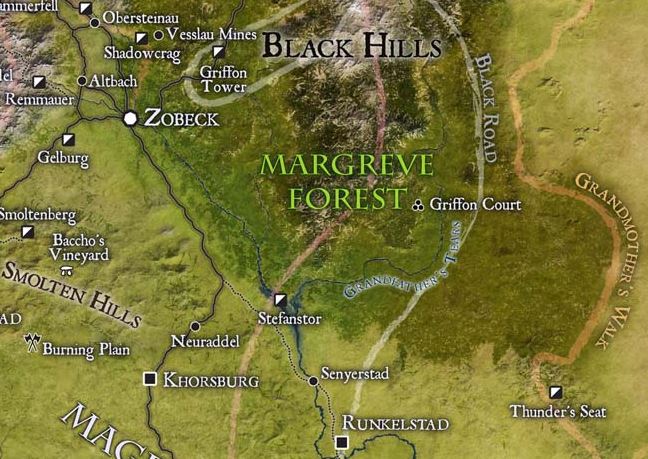
It’s Midgard Monday! Each week, we visit a corner of the wide world of Midgard. Look for standalone content every Monday that you can drop into your own campaign—whether it’s in Midgard or your own homebrew. Find new inspiration for your game, each Midgard Monday!
The Margreve is the oldest forest in the Crossroads, and among the largest forests in all of Midgard. They say the Margreve is three-quarters location and one-quarter magical beast.
And yet, all manner of creatures live there. How do native Margrevians survive the venoms, afflictions, pitfalls, and predators of their inscrutable homeland?
They would say the key is to diligently practice the Old Ways, rhymes and rituals to placate the Margreve’s foul tempers and sate its dark appetites.
But for every blood sacrifice and guardian effigy meant to ward off fey and fang, a practical remedy exists for everyday ills.
Remedies and Risks
Be careful with any remedy from the Margreve. The forest gives and takes, and often takes more than gives. While these remedies and traditions promise to cure sickness, thwart disease, and even dispel curses, misuse can lead to all sorts of risks.
The following herbal traditions of the Old Ways list how they’re used, how you can expect the Margreve or its agents to be involved, and what can go wrong.* Mechanical benefits are hinted at or suggested to give GMs latitude in allowing consistency and effectiveness of remedies.
Rose Hips
Rose hips are the small berry fruit from the wild dog rose, a fussy, thorny perennial that likes to grow around the bases of old griffon watchtowers. Cultivating wild dog roses is a difficult but rewarding endeavor for any gardener.
The Remedy. Rose hips are used to combat infection from dog and wolf bites and to treat stomach sickness. The mashed berry is typically used as both a poultice and a tea for maximum effect.
The Risk. Herbalists use Meadowsweet, a similar plant in appearance, to treat skin problems and fever. Confusing the two can lead to ineffectual, potentially fatal, treatment.
Adelbert Potatoes
These locally grown potatoes earn their name for how they look like little humans, caused by multiple tubers growing from one potato that look like appendages.
The Remedy. Any hedge witch worth her salt knows to treat warts, skin conditions, and minor curses by rubbing split potatoes on the afflicted, and then burying the potatoes in a fallow field. There, the transplanted affliction harmlessly starves.
The Risk. If the field contains other flora, some spite-fueled fiend might sprout from the buried potato. Tuberkith (see Tome of Beasts 3) sometimes react poorly to this tradition, for its superstition flies in the face of both tuberkith origins and insults the flourishing influence of the rootfolk.
White Horhound

White horehound (also called frost puppy or bitter mint) is well known for its ameliorative properties. It is easy to find in the central, eastern, and western regions of the forest.
The Remedy. While used to treat a broad swath of ailments ranging from bronchial to digestive to dermal illnesses, horehound is best used to treat a lost voice. In this way, white horehound must be prepared with reduced wine and buttercream from a mouthy mare.
The Risk. Never confuse white horhound for pale horhound (also known as sidhe’s foxglove or false horhound). If you do, you’ll surely attract wolves, blink dogs, or the dread hounds of the night (see Tome of Beasts) along with the unwelcome attention of their shadow fey masters.
Bark Biting
The bark of some Margreve trees, namely white-and-crack willow, argent poplar (often found near the River Argent and its tributaries), and the Margreve’s own Derende tree, are all used to chew on during long days of hard labor.
The Remedy. If you suffer pain and general malaise, chewing strips of willow or Derende tree bark helps ease even deep-set aches.
The Risk. Willow bark can cause nausea if chewed too long. Chewing Derende bark can also cause delirium, lucid dreaming, and in some rare cases, blindness. Unless the proper sacrifice is made beforehand (the planting of a sapling), stripping the bark from trees is a quick way to anger dryads and crueler fey.
Cowslip Primrose
This butter-yellow bellflower tastes sweet as honey and is a favorite of giant honey bees, grove bears, and Margreve stags.
The Remedy. Tucking cowslip primrose behind your ear combats melancholy, paranoia, and lethargy, while ingesting cowslip extract is said to thwart fear itself, and soothes a persistent cough.
The Risk. Fey, for better or for worse, enjoy the flower and find themselves drawn to its presence. The beasts mentioned above (all found in Margreve Players Guide) pose their own risks, especially during springtime mating season.
Greve Coursing
Though not herbalism, The alseid of the Margreve, elf-deer cousins to centaurs, swear by the act of running to solve problems. Perhaps it is their nature or their deep connection to the Margreve itself, but few diseases seem to keep the alseid down for long.
The Remedy. Few deny the efficacy of burning out a virulent disease with strenuous exercise. Typically, this alseid remedy is done freeform amidst the trees, lasts for many minutes and miles, and doesn’t end until the runner drops from exhaustion.
Runners might be allowed a saving throw against a disease (even if they already failed their saving throw for the day) in exchange for accruing levels of exhaustion.
The Risk. Running full tilt through the forest posts its own set of challenges, Exhaustion, twisted ankles, and impromptu predator-prey situations are all real risks with greve coursing.
Quillpoint
The quill-backed erina too have their methods for combating illness, using their quills for medicinal and therapeutic acupuncture.
The Remedy. Acupuncture of this sort typically takes an hour or more of concentrated effort from both the erina and the patient. Though painful and somewhat torturous, lasting benefits include increased alertness, peace of mind, and a heartier constitution.
A character spending a short rest in acupuncture with an erina healer (prompting an appropriate Wisdom (Medicine) check from the healer) might dealing damage to the paitent while also healing a disease or condition, such as deafened, poisoned, or 1 level of exhaustion.
Alternatively, this remedy can grant a brief bonus to the target’s Perception skill, Initiative, or Wisdom saving throw, not more than a day and not exceeding the erina’s proficiency bonus in benefit.
The Risk. Pain and loss of hit points are obvious drawbacks. Some claim addiction is possible.
*We humble kobolds cannot be held responsible for adverse reactions, incurred ire, or disapproval of Baba Yaga, the Countess of Garlands, or the Primal Tender of Midgard. Any information listed should not be construed as actual medical advice. Check with your life cleric before ingesting any mystical forest flora. Always confirm who you’re talking to when engaging in any fey bargain. Do not go logging after sunset.
Find out more about the Crossroad’s oldest forest, in Tales of the Old Margreve! Want to play as an alseid, erina, piney, or some other forest denizen? Pick up a copy of the Margreve Players Guide. And, you can learn more about hedge magic in Tome of Heroes.
Read more at this site
